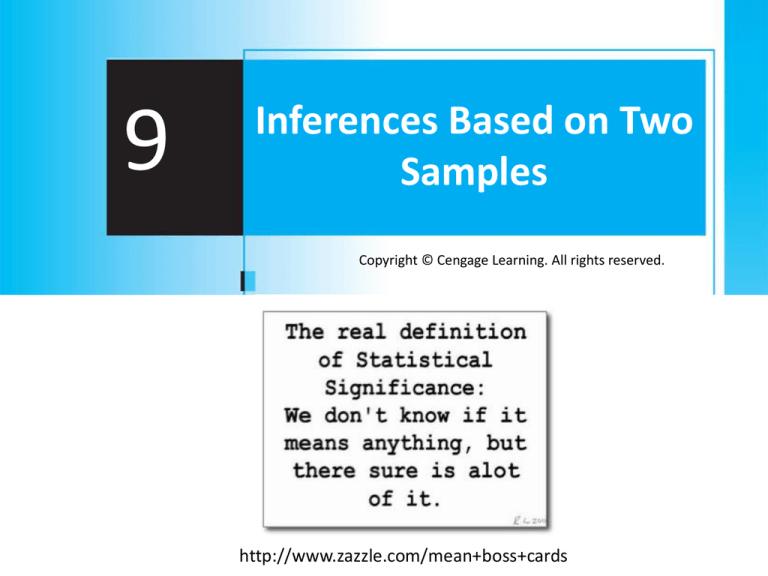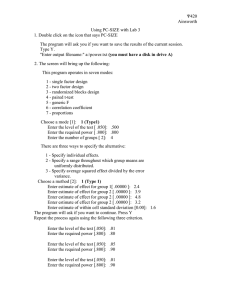
9
Inferences Based on Two
Samples
Copyright © Cengage Learning. All rights reserved.
http://www.zazzle.com/mean+boss+cards
Two-sample z tests: Assumptions
1. X1, …, Xn1 is a random sample from a
distribution with mean 1 and standard
deviation σ1.
2. Y1, …, Yn2 is a random sample from a
distribution with mean 2 and standard
deviation σ2.
3. X and Y are independent of each other.
2-Sample z-test; known variances:
Summary
Null hypothesis: H0: μ1 – μ2 = Δ0
Test statistic: z
x y 0
12
n1
22
n2
Alternative
Hypothesis
upper-tailed Ha: μ1 – μ2 > Δ0
lower-tailed Ha: μ1 – μ2 < Δ0
two-tailed Ha: μ1 – μ2 ≠ Δ0
Rejection Region
for Level α Test
z zα
z -zα
z zα/2 OR z -zα/2
P-values are calculated as before for z tests.
β(Δ’) Summary
Example 9.3: Difference, z-test, known σ
Yield strengths of cold-rolled steel: n1 = 20, sample
average = 29.8 ksi, σ1 = 4.0.
Yield strengths for two-sided galvanized steel: n2 = 25,
sample average = 34.7 ksi, σ2 = 5.0.
Assume that both distributions are normal.
Suppose that when the true difference differs by at
most 5, we want the probability of detecting that
departure to be 0.9. Does the above study with a
level 0.01 test satisfy this condition?
𝜎=
𝜎12 𝜎22
+
= 1.34
𝑛1 𝑛2
calculation (cont)
Calculation of n
𝜎12 𝜎22
Δ′ − Δ0
+
=
𝑛1 𝑛2
𝑧𝛼 + 𝑧𝛽
2
2
If n1 = n2 = n
2
𝜎1
2 2
+ 𝜎2
Δ′ −
2
𝑧𝛼 + 𝑧𝛽
𝑜𝑛𝑒 − 𝑡𝑎𝑖𝑙𝑒𝑑: 𝑛 =
Δ0 2
𝜎12 + 𝜎22 2 𝑧𝛼 2 + 𝑧𝛽
two − 𝑡𝑎𝑖𝑙𝑒𝑑: 𝑛 =
Δ′ − Δ0 2
2
Two-sample t tests: Assumptions
1. X1, …, Xn1 is a normal random sample from a
distribution with mean 1 and standard
deviation σ1.
2. Y1, …, Yn2 is a normal random sample from a
distribution with mean 2 and standard
deviation σ2.
3. X and Y are independent of each other.
Two-sample t-test: df
𝑑𝑓 = 𝜈 =
where
2 2
𝑠2
+
𝑛2
𝑠12 𝑛1 2
𝑠22 𝑛2 2
+
𝑛1 − 1
𝑛2 − 1
𝑠12
𝑛1
𝑠𝑒12 + 𝑠𝑒22 2
=
𝑠𝑒14
𝑠𝑒24
+
𝑛1 − 1 𝑛2 − 1
𝑠1
𝑠2
𝑠𝑒1 =
, 𝑠𝑒2 =
𝑛1
𝑛2
round down to the nearest integer
2-Sample t-test: Summary
Null hypothesis: H0: μ1 – μ2 = Δ0
Test statistic: t
x y 0
s12 s22
n1 n2
Alternative
Hypothesis
upper-tailed Ha: μ1 – μ2 > Δ0
lower-tailed Ha: μ1 – μ2 < Δ0
two-tailed Ha: μ1 – μ2 ≠ Δ0
Rejection Region for
Level α Test
t tα,
t -tα,
t tα/2, OR t -tα/2,
P-values are calculated as before for t tests.
Example: Difference, t-test, CI
A group of 15 college seniors are selected to participate in
a manual dexterity skill test against a group of 20
industrial workers. Skills are assessed by scores
obtained on a test taken by both groups. The data is
shown in the following table:
a) Conduct a hypothesis test to determine whether the
industrial workers had better manual dexterity skills
than the students at the 0.05 significance level.
b) Also construct a 95% confidence interval for this
situation.
c) What is the appropriate bound?
Group
n
x̄
s
Students 15
35.12
4.31
Workers
20
37.32
3.83
Paired t-test
Example 9.8. Trace metals in drinking water affect the
flavor, and unusually high concentrations can pose a
health hazard. The following is the results of a study
in which six river locations were selected and the
zinc concentrations in (mg/L) determined for both
surface water and bottom water at each location.
The six pairs of observations are displayed
graphically below.
Paired two-sample t tests: Assumptions
1. The data consists of n independent pairs (X1,
Y1), …, (Xn, Yn) with E(X1) = 1 and E(X2) = 2
2. The differences of each of the pairs is called
D. That is Di = Xi – Yi.
3. Assume that D is normally distributed with
mean D and standard deviation σD.
Paired t-test: Summary
Null hypothesis: H0: μD = Δ0
Test statistic:
d 0
t
sd / n
Alternative
Hypothesis
upper-tailed Ha: μD > Δ0
lower-tailed Ha: μD < Δ0
two-tailed Ha: μD ≠ Δ0
Rejection Region for
Level α Test
t tα,n-1
t -tα,n-1
t tα/2,n-1 OR t -tα/2,n-1
P-values are calculated as before for t tests.
Example: Paired t test
In an effort to determine whether sensitivity
training for nurses would improve the quality
of nursing provided at an area hospital, the
following study was conducted. Eight different
nurses were selected and their nursing skills
were given a score from 1 to 10. After this
initial screening, a training program was
administered, and then the same nurses were
rated again. On the next slide is a table of
their pre- and post-training scores.
Individual Pre-Training Post-Training Pre - Post
1
2
3
4
5
6
7
8
mean
stdev
2.56
3.22
3.45
5.55
5.63
7.89
7.66
6.20
5.27
2.02
4.54
5.33
4.32
7.45
7.00
9.80
5.33
6.80
6.32
1.82
-1.98
-2.11
-0.87
-1.90
-1.37
-1.91
2.33
-0.60
-1.05
1.47
Example: Paired t-test
a) Conduct a test to determine whether the
training could on average improve the quality
of nursing provided in the population at a
significance level of 0.05.
b) What is the appropriate 95% confidence
interval or bound of the population mean
difference in nursing scores?
c) What is the 95% confidence interval of the
population mean difference in nursing
scores?
Paired vs. Unpaired
1. If there is great heterogeneity between
experimental units and a large correlation
within paired units then a paired experiment
is preferable.
2. If the experimental units are relatively
homogeneous and the correlation within
pairs is not large, then unpaired experiments
should be used.
2-Sample z test: large sample size
p1 = the proportion of successes in population #1 (X)
p2 = the proportion of successes in population #2 (Y)
X~binomial(n1,p1) Y~binomial(n2,p2)
𝑋
𝑌
𝑝1 = , 𝑝2 =
𝑛1
𝑛2
E(p̂1 - p̂2) = p1 – p2
𝑝1 𝑞1 𝑝2 𝑞2
𝑉𝑎𝑟 𝑝1 − 𝑝2 =
+
𝑛1
𝑛2
2-Sample z test: large sample size
𝑝1 − 𝑝2 − (𝑝1 − 𝑝2 )
𝑍=
𝑝1 𝑞1 𝑝2 𝑞2
+
𝑛1
𝑛2
𝑝1 − 𝑝2
=
1
1
𝑝𝑞
+
𝑛1 𝑛2
𝑋+𝑌
𝑛1
𝑛2
𝑝=
=
𝑝1 +
𝑝2
𝑛1 + 𝑛2 𝑛1 + 𝑛2
𝑛1 + 𝑛2
2-Sample z-test; large sample,
proportions: Summary
Null hypothesis: H0: p1 – p2 = 0
Test statistic:z
pˆ 1 pˆ 2
1 1
ˆˆ
pq
n1 n2
Alternative
Hypothesis
upper-tailed Ha: p1 – p2 > 0
lower-tailed Ha: p1 – p2 < 0
two-tailed Ha: p1 – p2 ≠ 0
Rejection Region
for Level α Test
z zα
z -zα
z zα/2 OR z -zα/2
P-values are calculated as before for z tests.
Example: Large Sample Proportion Test
Two TV commercials are developed for marketing a
new product. A volunteer test sample of 200 people
is randomly split into two groups of 100 each. In a
controlled setting, Group A watches commercial A
and Group B watches commercial B. In Group A, 25
say they would buy the product, in Group B, 20 say
they would buy the product.
a) The marketing manager who devised this
experiment concludes that commercial A is better.
Do you agree or disagree with the marketing
manager at a significance level of 0.05?
β(p1,p2) Summary
p1q1 p2q2
n1
n2
n for large sample proportions
If n1 = n2, level α test, type II error probability β,
with alternative values p1 and p2 and p1 – p2 = d
𝑧𝛼
𝑛=
𝑝1 + 𝑝2 𝑞1 + 𝑞2
+ 𝑧𝛽 𝑝1 𝑞1 + 𝑝2 𝑞2
2
𝑑2
for one-tailed test
replace zα with zα/2 for a two-tailed test.
2
Example: Large Sample Proportion Test
Two TV commercials are developed for marketing a
new product. A volunteer test sample of 200 people
is randomly split into two groups of 100 each. In a
controlled setting, Group A watches commercial A
and Group B watches commercial B. In Group A, 25
say they would buy the product, in Group B, 20 say
they would buy the product.
b) What is the 95% confidence interval for the buying
of the product for Group A and Group B?



